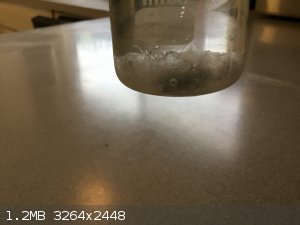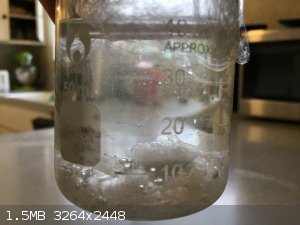Jackson
Hazard to Others
  
Posts: 189
Registered: 22-5-2018
Location: U S of A
Member Is Offline
Mood:  Happy about new glassware 
|
|
Tungsten compound
I was reacting a tungsten weight with 30% H2O2 and sulfuric acid to try and produce tungstinic acid. The photos of tungstinic acid shows it as a
yellow color. The solution so far is a cloudy gray. My question is, is tungstinic acid clear in solution?
|
|
|
fusso
International Hazard
    
Posts: 1922
Registered: 23-6-2017
Location: 4 ∥ universes ahead of you
Member Is Offline
|
|
Yes, both WO3 & H2WO4 are yellow. Gr(e/a)y means either the W hasn't done reacting or is unreactive towards H2O2. H2WO4 is insoluble.
|
|
|
Jackson
Hazard to Others
  
Posts: 189
Registered: 22-5-2018
Location: U S of A
Member Is Offline
Mood:  Happy about new glassware 
|
|
I was looking at the solution which is violently bubbling and it appears to be small pieces of metal.
There is also now a small amount of yellow precipitate on the bottom.
[Edited on 10/6/2018 by Jackson]
|
|
|
diddi
National Hazard
   
Posts: 723
Registered: 23-9-2014
Location: Victoria, Australia
Member Is Offline
Mood: Fluorescent
|
|
it take ages (weeks) to dissolve W. and i have found it is quicker in just H2O2. ie no acid
Beginning construction of periodic table display
|
|
|
Jackson
Hazard to Others
  
Posts: 189
Registered: 22-5-2018
Location: U S of A
Member Is Offline
Mood:  Happy about new glassware 
|
|
The piece of tungsten has lost about half of its volume but there is nothing dropping out
|
|
|
Jackson
Hazard to Others
  
Posts: 189
Registered: 22-5-2018
Location: U S of A
Member Is Offline
Mood:  Happy about new glassware 
|
|
Does H2WO4 and WO3 disolve in H2O2 or H2SO4?
|
|
|
fusso
International Hazard
    
Posts: 1922
Registered: 23-6-2017
Location: 4 ∥ universes ahead of you
Member Is Offline
|
|
W(VI) is acidic. If they aren't soluble in H2O, I don't think
they'll dissolve in H2O2 or H2SO4 either.
[Edited on 07/10/18 by fusso]
|
|
|
Jackson
Hazard to Others
  
Posts: 189
Registered: 22-5-2018
Location: U S of A
Member Is Offline
Mood:  Happy about new glassware 
|
|
Ok its weird because the tungsten is around 1/3 of its size and the solution is clear so i dont know where it is going.
|
|
|
fusso
International Hazard
    
Posts: 1922
Registered: 23-6-2017
Location: 4 ∥ universes ahead of you
Member Is Offline
|
|
Quote: Originally posted by Jackson  | I was looking at the solution which is violently bubbling and it appears to be small pieces of metal.
There is also now a small amount of yellow precipitate on the bottom.
[Edited on 10/6/2018 by Jackson] |
The yellow ppt dissolved? Try boil down the solution to see if any tungstic
acid crystallized out. If yes then I think wiki is wrong. (wiki says tungstic acid is insoluble)
[Edited on 07/10/18 by fusso]
|
|
|
diddi
National Hazard
   
Posts: 723
Registered: 23-9-2014
Location: Victoria, Australia
Member Is Offline
Mood: Fluorescent
|
|
it is typically pale yellow solution even in 50% H2O2
Beginning construction of periodic table display
|
|
|
Foeskes
Hazard to Others
  
Posts: 156
Registered: 25-2-2017
Member Is Offline
Mood: No Mood
|
|
I made tungstic acid by heating tungsten rods in a mix of NaNO3 and NaOH, once it starts it reacts violently and heats up all the way to over 600c.i
dissolved the mix in water.
After wards I filtered and added a bit of a reducing to remove the chromium(vi). Finally I added some hcl and filter.
[Edited on 8-10-2018 by Foeskes]
|
|
|
phlogiston
International Hazard
    
Posts: 1379
Registered: 26-4-2008
Location: Neon Thorium Erbium Lanthanum Neodymium Sulphur
Member Is Offline
Mood: pyrophoric
|
|
I dissolved tungsten rods in straight 10% H2O2. It took months, and yielded a yellow solution. It was perfectly clear at first, but a small amount of
bright yellow precipitate formed spontanously over time. This was only a very small fraction of the tungsten in the solution, however.
The precipitate redissolved when I added NaOH solution.
From the resulting clear, slightly yellow solution, tungstic acid was precipitated by adding hydrochloric acid. The precipitate was very voluminous
(consistency is a bit gel-like). It took ages to filter and dry.
-----
"If a rocket goes up, who cares where it comes down, that's not my concern said Wernher von Braun" - Tom Lehrer |
|
|
woelen
Super Administrator
        
Posts: 8012
Registered: 20-8-2005
Location: Netherlands
Member Is Offline
Mood: interested
|
|
Pure tungsten dissolves in 10% H2O2 fairly easily, no acid added. In one day you can dissolve a mm of metal from a rod. The resulting solution is
(nearly) colorless, not yellow. I have done this experiment myself, using small rods of very pure tungsten, I purchased on eBay.
The solid oxide, WO3 is yellow, looking very much like sulphur. Solutions of H2WO4 tend to be colloidal, but nearly colorless and clear (index of
refraction of the colloidal particles is very close to that of water), When the particles become larger, then the liquid becomes pale yellow.
Solid H2WO4 also is yellow, somewhat paler than WO3, but definitely yellow, not off-white.
If you get a turbid grey liquid, then most likely your tungsten is not really pure. A common impurity is carbon. The tungsten then dissolves and very
fine particles of carbon (or tungsten carbide? I do not know for sure) give the dark grey color. Just allow this to settle. This may take many hours,
or even days. Then carefully decant the clear liquid or use a pipette to carefully take it away from the layer of precipitated dark material.
|
|
|
Mesa
Hazard to Others
  
Posts: 264
Registered: 2-7-2013
Member Is Offline
Mood: No Mood
|
|
<---someone who has oodles and oodles of tungsten around and experimented with it quite a lot.
tungsten dissolves fairly well in H2O2 to yield a colorless H2WO4 soln which is unstable. soln slowly takes on yellowish tinge as WO3 precipitates
out.
eventually all dissolved tungsten precipitates as WO3.x2O.
edit: to not contradict woelen's comment above; i dont make a distinction between solid H2WO4 and WO3.(1)H2O and I'm not sure if such a distinction
exists. So we are kinda saying the same thing imo.
I think of H2WO4 as specifically the dissolved species.
[Edited on 8-10-2018 by Mesa]
[Edited on 8-10-2018 by Mesa]
|
|
|
Jackson
Hazard to Others
  
Posts: 189
Registered: 22-5-2018
Location: U S of A
Member Is Offline
Mood:  Happy about new glassware 
|
|
The solution is grey due to the color of acid I added to it. There is a dark grey precipitate at the bottom. The tungsten rod is around 1/3 to 1/4 of
its original size.
[Edited on 10/8/2018 by Jackson]
|
|
|
Jackson
Hazard to Others
  
Posts: 189
Registered: 22-5-2018
Location: U S of A
Member Is Offline
Mood:  Happy about new glassware 
|
|
Large White crystals have formed on the bottom of the container.
|
|
|
Jackson
Hazard to Others
  
Posts: 189
Registered: 22-5-2018
Location: U S of A
Member Is Offline
Mood:  Happy about new glassware 
|
|
Here are some photos of it
 
|
|
|
Jackson
Hazard to Others
  
Posts: 189
Registered: 22-5-2018
Location: U S of A
Member Is Offline
Mood:  Happy about new glassware 
|
|
What compound could it be?
Could it be sodium/potassium tungstate?
There maybe have been sodium or potassium salts in the cleaner.
|
|
|
Fery
International Hazard
    
Posts: 1015
Registered: 27-8-2019
Location: Czechoslovakia
Member Is Offline
|
|
Quote: Originally posted by woelen  | Pure tungsten dissolves in 10% H2O2 fairly easily, no acid added. In one day you can dissolve a mm of metal from a rod. The resulting solution is
(nearly) colorless, not yellow. I have done this experiment myself, using small rods of very pure tungsten, I purchased on eBay.
The solid oxide, WO3 is yellow, looking very much like sulphur. Solutions of H2WO4 tend to be colloidal, but nearly colorless and clear (index of
refraction of the colloidal particles is very close to that of water), When the particles become larger, then the liquid becomes pale yellow.
Solid H2WO4 also is yellow, somewhat paler than WO3, but definitely yellow, not off-white.
|
I have to confirm that W dissolves in H2O2, just by my experiments not so easily (maybe too much stabiliser in my H2O2 ?).
Pertungstic acid forms while still excess of H2O2, only when H2O2 consumed near the end and there is still excess of W, then poorly soluble tungstic
acid starts to precipitate (pertungstic acid is then very likely source of some H2O2).
|
|
|